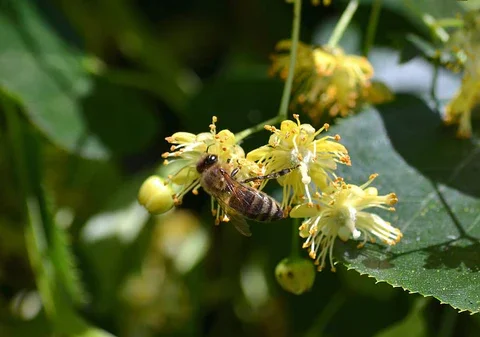Plant Profile: Linden
Linden - Queen of the Bees
As tall grasses come up to meet the palm, the wrist twists and trailing fingers brush through grass heads, releasing pollen and moths and a cloud of midges to dance in the hot afternoon sun. Near our home is a great linden tree standing along the fruiting borders of the hedgerow. This green flowering tree, consisting of coarsely toothed heart-shaped leaves and small, delicate yellow and white flowers releases a mouth watering, crisp, honey-like citrus fragrance from its blossoms…
With a lightly floral, sweet honey-like taste the bees adore her. Linden leaf and flower are a relaxing nervine remedy for the anxious, swift energy of the summer months, while also soothing the upper respiratory system during seasonal allergies. Linden is both demulcent and astringent, making it a perfect remedy for excessive dryness. The demulcent qualities add moisture to the body, while the astringent qualities tighten and tone tissues, helping retain moisture. Linden excels in protecting mucus membrane health in dry and hot weather or in people who tend to be dry and hot. For all of these reasons I drink linden daily through the late summer. My favorite way to enjoy linden in the summer is in iced tea sweetened with an extra aromatic dose of our richly infused Linden honey. (plus a little cream is always a treat) You can also find Linden in our Language of Flowers herbal smokes, and our Calm Spirit tea blend. Topically, think of linden for dry and irritated skin. This is another reason I love linden infused in a honey, to use as a honey poultice topically on sun burns and rashes.
While linden trees are revered globally, particularly all over Europe and parts of Asia and North America, the folklore and recorded medicinal uses for the linen tree are especially rich in Slavic countries. Linden (lipa) is considered to be a sacred tree in Poland, where the village name of Święta Lipka, literally translates to “Sacred Lime Tree”, and is a pilgrimage destination. To this day, the tree is a national emblem of the Czech Republic, Slovakia, Slovenia, and of the Sorbs in Lusatia. Lipa gave name to the traditional Slavic name for the month of June (Croatian, lipanj) or July (Polish, lipiec, Ukrainian “lypen’/липень”). Linden is a big deal in Slavic mythology, and is related to the diety Mokosh.
Mokosh is the goddess of weaving and the protector of women. She was particularly popular among the Eastern Slavs. Mokosh protects women and ensures safe pregnancy and childbirth. As the goddess of weaving, Mokosh also protects sheep and their wool. Mokosh is associated with bees and sheep, as well as flax and the linden tree.
In Norse mythology, the linden tree is particular to the goddess of love and fertility, Freya, and the goddess of love and marriage, Frigga. Later in history, the Romans in Slavic regions saw the Linden tree as a symbol of stability and marital love. There was once a point where newlyweds would decorate their homes with linden tree branches to keep away evil spirits that may cross the threshold and disturb with the couple's happiness. Until Saints Cyril and Methodius spread Christianity to this region, the Linden tree was associated with truth and justice. Germanic tribes in Western Slovak regions would hold official proceedings ranging from criminal trials to marriage ceremonies under the branches of linden trees because there was a firm belief that a person couldn’t lie in the presence of the trees.
If you could use a little support through anxiety (as often feel I could use late into the busy Summer) check out our offerings that incorporate this unique and revered flower:
We’re always happy to chat herbs, make custom blends, or help you figure out what your nervous system needs. Stop by the shop or drop us a message—we’re here to help you feel calm, grounded, and nourished through all the seasons.
With heart,
Teresa



